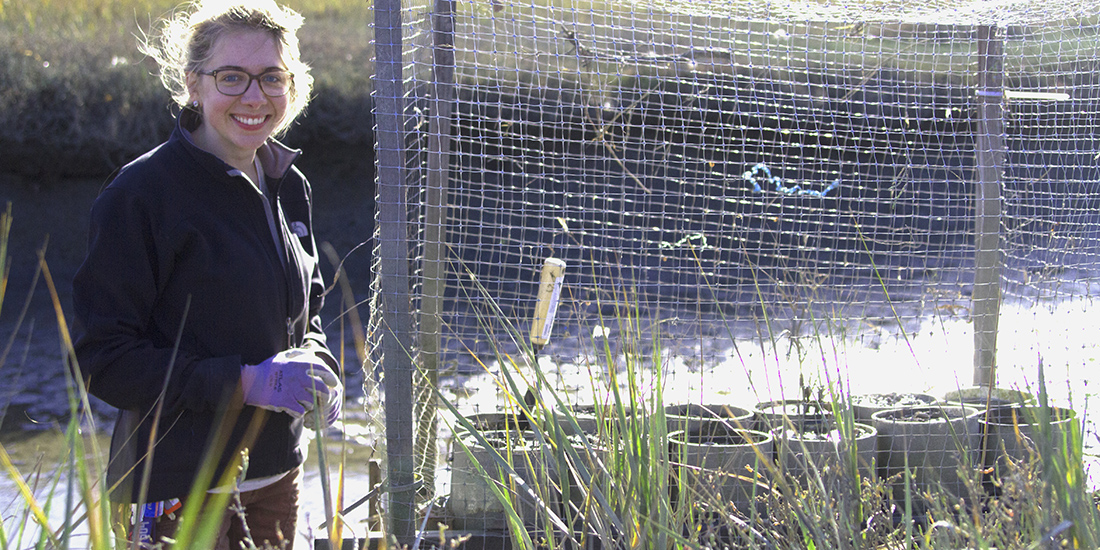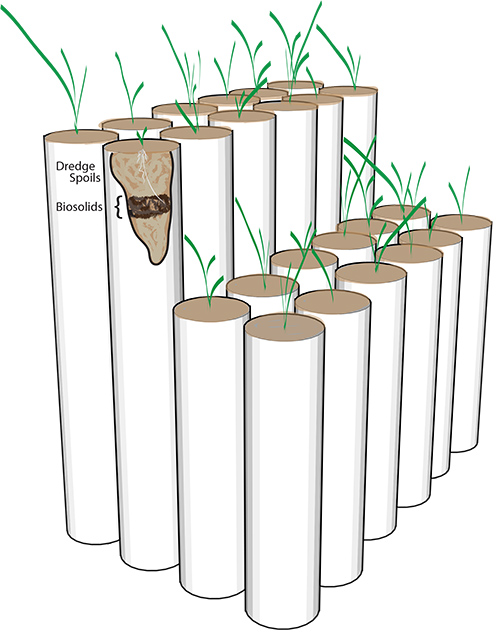 Madeline Foster-Martinez with the marsh organ she built at Richmond Field Station. (Photo by Daniel McGlynn)
Madeline Foster-Martinez with the marsh organ she built at Richmond Field Station. (Photo by Daniel McGlynn)Building an organ in the marsh
Madeline Foster-Martinez leans her bike up against a 10-foot-tall chain-link fence at the Richmond Field Station and pulls on calf-high black rubber boots, tucking in the hem of her rust-red Carhartt pants. She opens a gate and enters a rebuilt upland on the fringe of 10 acres of Stege Marsh. She’s here to check on an instrument she has built as part of her doctoral research in environmental engineering. Called a marsh organ, the simple device measures the effectiveness of using biosolids — treated sewage sludge from wastewater treatment plants — as tidal wetland restoration material.

Foster-Martinez is using the marsh organ to study how to incorporate biosolids in restoration work. (Image courtesy researcher)
Foster-Martinez grew up in New Orleans. She remembers hearing about Louisiana’s disappearing marshes as a child; every year her family would donate their Christmas tree to a project that used the trees to control erosion. Although she comes from a family of engineers — her dad and grandfathers all worked in the oil and gas industry — she planned to study law or policy to advocate for environmental protection.
She was a junior in high school when Hurricane Katrina hit southeast Louisiana and everything changed. “Anyone who lived through Katrina will tell you that engineering is very real,” says Foster-Martinez. The massive failure of levees and seawalls and the subsequent flooding caused more than 1,200 deaths, destroyed large swaths of New Orleans and became the costliest disaster in U.S. history. “Engineering has huge impacts and is very connected to every part of society,” she says.
Foster-Martinez decided she wanted to become an engineer and studied at the Cooper Union, an architecture, art and engineering school in the heart of Manhattan. She was looking for ways to better understand what had just happened to her hometown and hoped to play a role in rebuilding. She read books, like Rising Tide, an analysis of the impact of the 1927 Mississippi River floods, worked with an engineering education non-profit in the South Bronx and spent summers in Ghana doing fieldwork.
As college ended, a career path was taking shape — she liked research and teaching, so continuing in academia seemed like a logical progression. She heard about a fellowship from the National Science Foundation (NSF) that funds graduate student research.
Foster-Martinez pitched the idea of investigating ways to improve large-scale marsh restoration, which currently consists of adding dredging spoils to a thinning marsh. But sandy dredging materials often lack the organic material that holds a tidal mudflat together, leaving the newly added material susceptible to erosion and providing inadequate support for marsh plants.
With NSF funding secured, she starting looking for graduate programs and applied to Berkeley. She was accepted and joined the environmental fluid mechanics lab. For her doctoral research, she is studying the interplay of forces that build, or destroy, marshes.
In the dormant Stege Marsh during low tide, she is working her way down the edge of a creek to check the progress of the plantings in the marsh organ she has built. She steps from the bank and sinks deep into the mud at the bottom of a tidal channel.
A marsh organ is a series of stepped tubes, in this case two layers of thick-walled, six-inch-diameter PVC pipe. Foster-Martinez’s marsh organ is a riff on similar instruments built by researchers elsewhere to monitor how sea level rise affects marsh plants. Modifying the marsh organ to study biosolids is a new line of inquiry. “There is enough out there on the effects of nutrients, effects of organic matter and that type of thing. It’s not too hard to piece together, but no one has.”
Some of the tubes in Foster-Martinez’s marsh organ are packed with dredge material from the Port of Oakland along with biosolids from the San José-Santa Clara Regional Wastewater Facility. During December, ahead of the endangered Ridgeway’s rail nesting season, she will plant native cordgrass she collects nearby into two levels of tubes with dredge spoils plus biosolids, as well as control tubes that contain dredge spoils only.
The first test will be to see if there is a difference between how the plants grow; the next step will be to analyze what’s happening below the surface. “We could take a core of the marsh and runs some tests on it in the lab — put it in a flume and throw waves at it and see how fast it erodes,” she says. “We also might CT-scan it, which would be really cool.” Imaging the core sample would allow researchers to get an idea of how root structures are developing in different soils, a better indicator of marsh health than solely examining the tops of the plants.
“Marshes are just incredible — not only are they cleaning out pollutants, but they sequester carbon, attenuate storm surge and provide habitat and food — they do it all.” she says.
